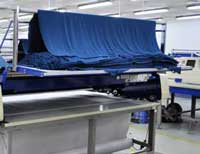
Glyoxal 40%
CAS No.:
107-22-2
Molecular Formula:
C2H2O2
Molecular Weight:
58.04
Structure Formular:
Properties:
Glyoxal 40%(107-22-2) is the crystalline or liquid crystalline or liquid that is colorless or yellow. The formula of glyoxal is C2H2O2. This kind of aldehyde is soluble in ethanol, and ether, and soluble in water. Chemically active, it also can be added or condensed with ammonia, amide, aldehyde, and carboxyl compounds.
Specifications:
Glyoxal 40% supplied by IRO has three grades. They are top-grade, first grade and industry-grade. Different grades, different specifications. All grades are supported by advanced technology and professional service from IRO Biocide. The details as below:
| Item | Index | ||
|---|---|---|---|
| Top-grade | First-grade | Industry-grade | |
| Chroma Pt-Co unit Color No. | ≤ 10# | ≤ 15# | ≤ 15# |
| Glyoxal | ≥ 40%±0.5% | ≥ 40%±0.5% | ≥ 40%±0.5% |
| Methanol | 6%~7% | 6%~7% | |
| Acid (formic acid) | ≤ 0.1% | ≤ 0.15% | ≤ 0.2% |
| Aldehyde (formaldehyde) | ≤ 0.1% | ≤ 0.2% | ≤ 0.3% |
| Glycol | ≤ 1.0% | ≤ 1.5% | ≤ 1.5% |
Preparation:
The main industrial production methods are gas-phase catalytic oxidation of ethylene glycol and nitric acid oxidation of acetaldehyde.
1. Gas-phase catalytic oxidation of ethylene glycol.
The catalytic oxidation of ethylene glycol and air in the presence of a copper catalyst at 250-300°C produces glyoxal. The active component of the catalyst is copper oxide (containing Cu03-8%). The carrier is alumina or is made of corundum, aluminum sand, impregnated with copper nitrate, and roasted. The catalyst has a service life of one year and is regenerated by cauterization.
The glycol is preheated and gasified and mixed with circulating gas into the catalytic reactor. The amount of fresh air is controlled to prevent deep oxidation of the glycol. And a nitrogen gas stream is used to bring in halogen compounds as inhibitors of deep oxidation. The reaction is carried out at 275°C and 0.74 MPa pressure. The reaction product is chilled with water. Absorption and refinement are the finished product. The one-way conversion of ethylene glycol is 80-85%.
2. Acetaldehyde nitric acid oxidation method.
Using copper nitrate as a catalyst. The liquid phase oxidation is carried out with nitric acid. Under the condition of stirring and sufficient cooling, acetaldehyde and nitric acid are each prepared into about 50% solution, copper nitrate into 40% solution, and sodium nitrite into 5% solution.
Add a small amount of nitric acid solution and acetaldehyde solution to the reaction pot first. Then put in the sodium nitrite solution. Heat slightly until brownish-red gas occurs. Naturally, raise the temperature to 30°C. Begin to add a small amount of nitric acid solution and acetaldehyde solution dropwise at the same time. About 4h add up. The reaction temperature is controlled at 40-45℃. The escaped acetaldehyde gas is absorbed by water and added to the reaction pot and the reaction continues for 3h.
The ingredients of acetaldehyde in the reaction are overdosed (by molar ratio, nitric acid: acetic acid = 1:2). After the reaction, acetaldehyde was recovered by heating to 98°C. Then activated carbon was added to decolorize, cooled, filtered, and washed with water. The filtrate and the washings were combined. Evaporate the organic acid below 70℃ (21.33kPa). Repeatedly replenish water, and steam again until the acidic cation exchange resin and weakly basic anion exchange resin in the distillate, removing impurities. The exchange solution and eluate are concentrated to obtain a qualified concentration of glyoxal. In terms of glyoxal, the yield is about 32%.
Applications:
What is glyoxal 40% used for? Glyoxal (107-22-2) is a kind of fine chemical product with a wide range of applications. This aldehyde is mainly used in chemicals, medicine, paper making, flavor, coating, adhesive, and daily-use chemicals, etc. It can be directly synthesized into imidazole, 2-methylimidazole, glyoxalic acid, textile finishing agent, iron-free resin and paper-making auxiliaries, etc.
In the textile industry, the aldehyde can increase the spinning and anti-wrinkle of cotton, and nylon as a fiber treatment agent. In Japan, 80% consumption of glyoxal is used as a fiber treatment agent. The glyoxal biocide is an insoluble adhesive. It is also used in the leather industry and waterproof match production.
Glyoxal 40% can be used as a biocide for water-based oil well-fracturing fluid, a cross-linking agent for cellulose, etc. In the pharmaceutical industry, glyoxal is condensed with amines to form 2-hydroxypyrazine. It is used as a raw material for sulfonamides and insecticides, etc. In coatings and adhesives, cross-linking with polymers can improve the water resistance of copolymers. Acryloylenal copolymers are cross-linked with glyoxal to make glass fiber sheets.
Packing and Storage:
Packed in 200L plastic pail in cool, dry and draughty place.
Store in a cool, ventilated warehouse. Keep away from fire and heat sources. The package should be sealed and not in contact with air. It should not be stored for a long time to avoid deterioration. It should be stored separately from alkali, acid and wet items.
Hazard Overview:
- The LD50 for rats is 2020 mg/kg and for mice is 600 to l000 mg/kg (based on 100% glyoxal). Glyoxal can strongly irritate the mucous membrane of the skin. It may be harmful to humans when inhaled, ingested, or absorbed through the skin. The vapor of glyoxal is irritating to the eyes, skin, mucous membranes, and upper respiratory tract.
- Environmental hazards: It is harmful to the environment, and pollution to the atmosphere.
- Explosion hazard: Glyoxal is poisonous and irritating.
Synonyms:
Ethanedial, Oxalaldehyde.







